
The Bottom Line
Introduction, Pricing & Availability
EVGA is no stranger to the enthusiast, as the company has become synonymous with high-end, incredibly well-built products - especially video cards. The company has some of the best-looking video cards, which also happen to perform even better.
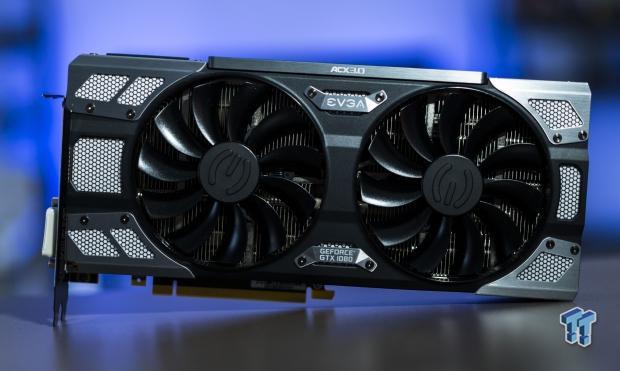
There are plenty of gamers out there who have waited for EVGA to release their GeForce GTX 1080 and GTX 1070 cards, and man, they really haven't disappointed with the GTX 1080 FTW. Their latest range has seen the deployment of the GeForce GTX 1080 FTW card, with EVGA's take on NVIDIA's new high-end video card adding some more performance, superior cooling, and more power delivery.
EVGA has made quite a few changes to its ACX cooler, with the new ACX 3.0 cooler keeping the GP104 and its 8GB of GDDR5X nice and cool - all while it's styled beautifully, with some RBG, LED to boot. I'm not usually a fan of RGB LEDs on a video card, but EVGA has gone with a more minimal use on the lights - so it adds to the look of the card, without making it stand out and make me feel like I'm going to have a seizure, or grab out the glow sticks and start dancing with my sunglasses on.
Finally, while NVIDIA's GeForce GTX 1080 Founders Edition was fast, we knew the AIB partners would have some exciting third-party coolers and custom PCB-based GeForce GTX 1080s that would be better products. With EVGA's new cooling technology, expertise in building high-end enthusiast video cards, and the pre-overclocked settings with some more OC headroom included - will it outperform the GTX 1080 Founders Edition and be the card we hope it is? Let's find out.
Pricing & Availability
If there's one thing that's hurting the sales of the GeForce GTX 1080 cards right now, it's the inflated price, with EVGA being caught in the middle of it. At the time of writing, EVGA's new GeForce GTX 1080 FTW GAMING ACX 3.0 card was listed on Amazon for $989.95, with just one of them left in stock. The availability should improve in the coming weeks, too.
Specifications, Detailed Look, & Cooling Technology
Specifications
EVGA always provides some pretty high-end overclocks on their products, with the GeForce GTX 1080 FTW GAMING ACX 3.0 rocking some great Boost clocks on the GP104 GPU. The EVGA GeForce GTX 1080 FTW GAMING ACX 3.0 has 1721/1860MHz Base/Boost clocks, with its 8GB of GDDR5X clocked at 10GHz - so no overclocking on the GDDR5X, but that's what manual overclocking is here for, right?
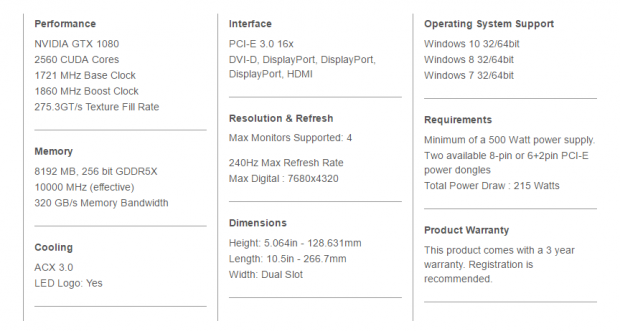
Here we have a detailed look at the specifications on the EVGA GeForce GTX 1080 FTW GAMING ACX 3.0 video card.
Detailed Look
EVGA's GeForce GTX 1080 FTW GAMING ACX 3.0 was the first custom GeForce GTX 1080 that I saw at Computex 2016 this year, and I instantly fell in love with the new ACX 3.0 cooler that EVGA used. It's not just a great looking cooler, but it keeps to the 2-slot design which I love - compared to some of the rather large GTX 1080s out there now that are 2.5-slot.
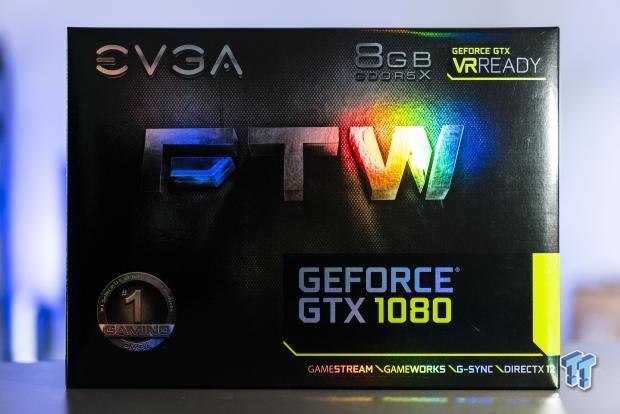

EVGA provides some luscious packaging as always, with the box looking great in person - and it'll attract eyes on retail shelves, too.
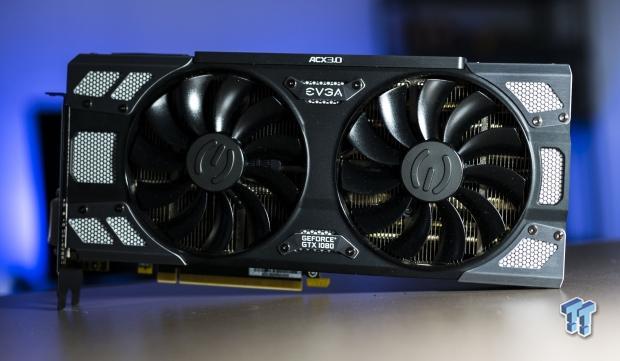
The front of the card looks great, with the ACX 3.0 in center view. EVGA has provided some slick branding at the top, with the same at the bottom indicating this is the GeForce GTX 1080. ACX 3.0 branding is splashed at the top, with two double ball bearing 10cm fans keeping the entire card cool. The aesthetics of the GTX 1080 FTW GAMING ACX 3.0 are out of this world, and we haven't even mentioned the adjustable RGB LEDs, either.

The back of the card is equally as sexy, with a backplate and EVGA branding on the back. The backplate on the GTX 1080 FTW GAMING ACX 3.0 cards is one of the best-looking backplates I've seen, and sure - the backplate isn't something worth talking about excessively, but looks are a big part of spending more than $600 on a new video card.
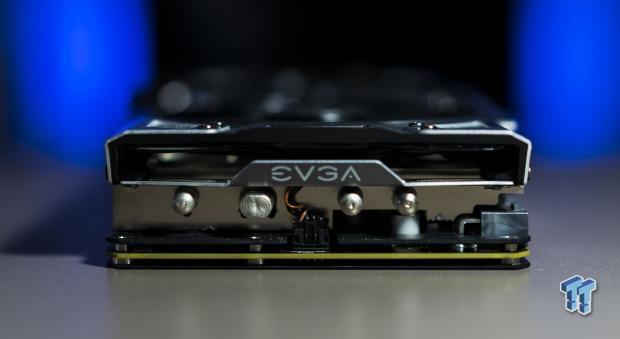
The cooling system runs right to the edge, but it doesn't hang over the edge like other custom GTX 1080s.


Even the top of the GTX 1080 FTW GAMING ACX 3.0 is styled like a boss, with some of the best branding on the top of a video card I've ever seen. It lights up and looks great in a dark case. You can see the ACX 3.0 cooling throughout the card, ending in the 8+8-pin PCIe power connections. The SLI bridge is also covered with a rubber-like material, which provides an additional tick to the premium look. The bottom of the card is plain, with the ACX 3.0 cooler in perfect view, as well as the rather large heat sink array.
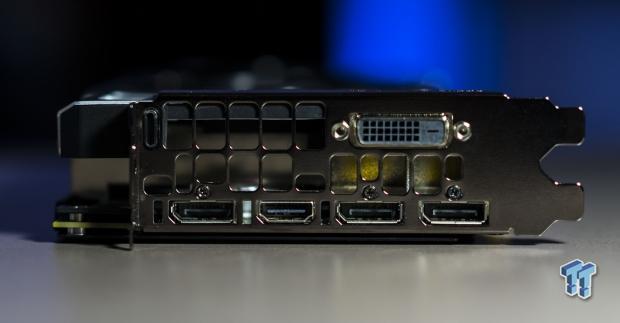
EVGA provides 3 x DP 1.4 connections, 1 x HDMI 2.0b and a single DVI connection on the GTX 1080 FTW GAMING ACX 3.0 card.
ACX 3.0 Kicks Some Serious Cooling Ass
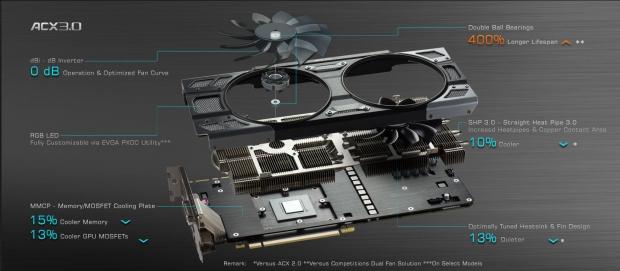
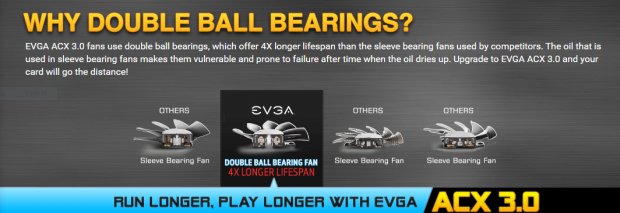
EVGA's new ACX 3.0 cooler is an incredible piece of engineering, with enough cooling technology to keep your gaming sessions quiet, and your overclocked card nice and stable.
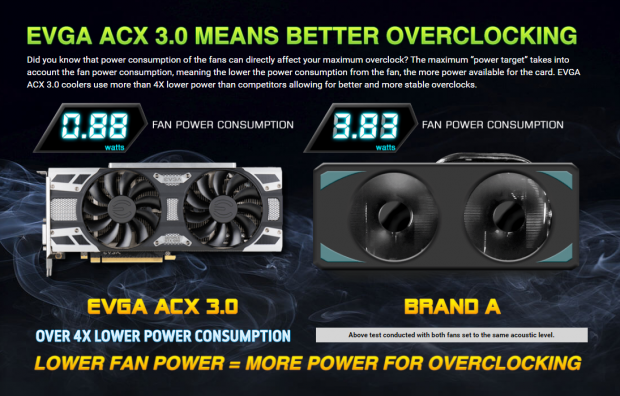
Right down to the power consumption of the two 10cm fans is considered with EVGA's new ACX 3.0 cooler, where the ACX 3.0 coolers use over 4x less power than competing cards, for better, more stable overclocks.

Don't forget the 8GB of GDDR5X RAM clocked at 10GHz on the EVGA GeForce GTX 1080 FTW GAMING ACX 3.0 card.
Testing Methodology & Test Setup Configuration
Testing Method
For the purposes of testing the EVGA GeForce GTX 1080 FTW GAMING ACX 3.0, and for all future GPU reviews and articles, we've changed up our benchmark suite. I've removed Battlefield 4, GRID: Autosport, BioShock: Infinite, and Grand Theft Auto V. In their place, I've got Far Cry Primal and The Division.
I've also added in some DX12 testing, with Hitman and Ashes of the Singularity. This will provide us with enough variety, but I'm on the hunt for new benchmarks all the time. The second that Battlefield 1 drops, we'll be including that in our GPU reviews, while I'll also be keeping an eye out on the release of Deus Ex: Mankind Divided.
Test System Configuration
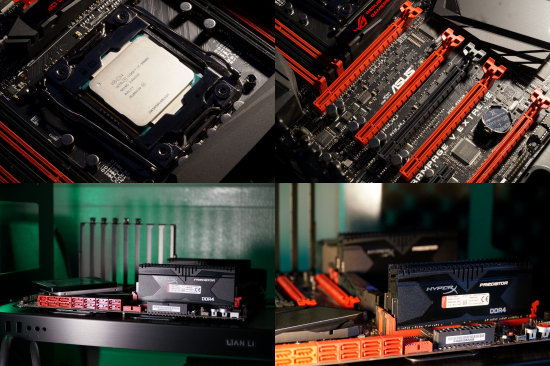
Corsair sent us over their kick-ass AX1500i PSU, which provides 1500W of power for our 3 and 4-way GPU testing that we have coming very soon.
Anthony's Video Card Test System Specifications
- Motherboard: ASUS Rampage V Extreme - Buy from Amazon / Read our review
- CPU: Intel Core i7 5960X - Buy from Amazon / Read our review
- Cooler: Corsair H110 - Buy from Amazon / Read our review
- Memory: Kingston 16GB (4x4GB) HyperX Predator DDR4 3000MHz - Buy from Amazon
- Storage #1: SanDisk Extreme II 240GB - Buy from Amazon / Read our review
- Storage #2: Intel 730 Series 480GB - Buy from Amazon / Read our review
- Case: Lian Li PC-T80 Open-Air - Buy from Amazon
- Power Supply: Corsair AX1500i - Buy from Amazon / Read our review
- OS: Microsoft Windows 10 Home 64-bit - Buy from Amazon
- Drivers: NVIDIA GeForce 368.39 and AMD Catalyst 16.6.2 hotfix
Benchmarks - Synthetic
3DMark Fire Strike - 1080p
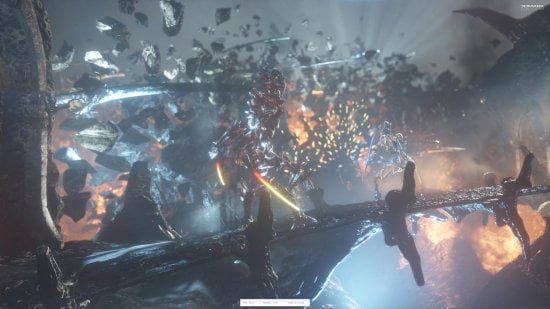
3DMark has been a staple benchmark for years now, all the way back to when The Matrix was released and Futuremark had bullet time inspired benchmarks. 3DMark is the perfect tool to see if your system - most important, your CPU and GPU - is performing as it should. You can search results for your GPU, to see if it falls in line with other systems based on similar hardware.
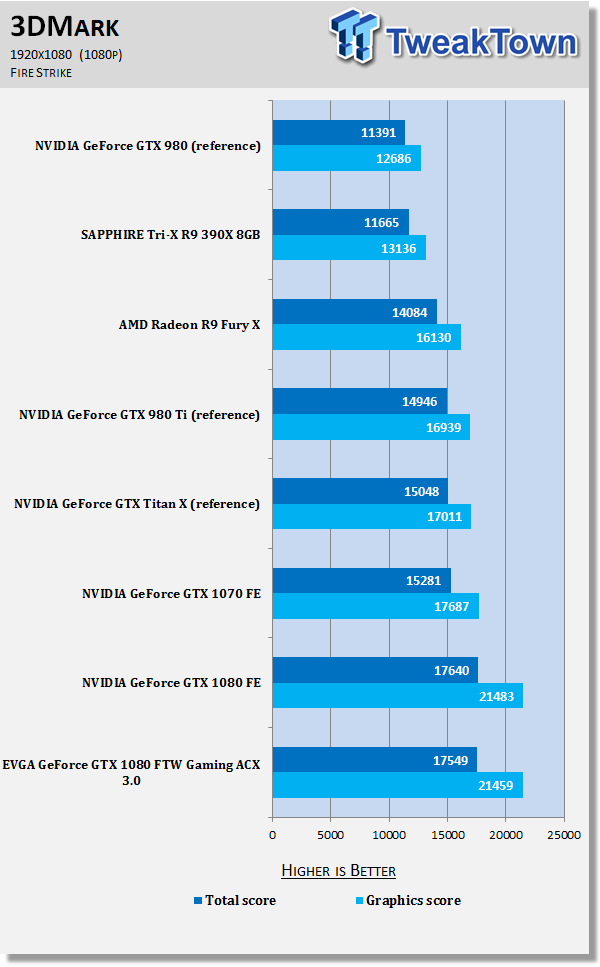
3DMark Fire Strike Extreme - 1440p
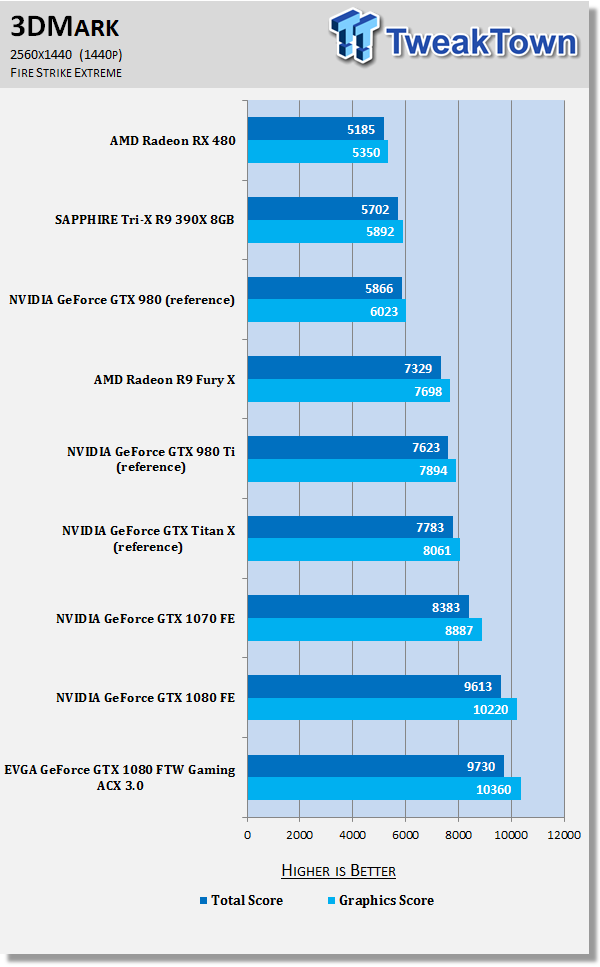
3DMark Fire Strike Ultra - 4K (3840x2160)
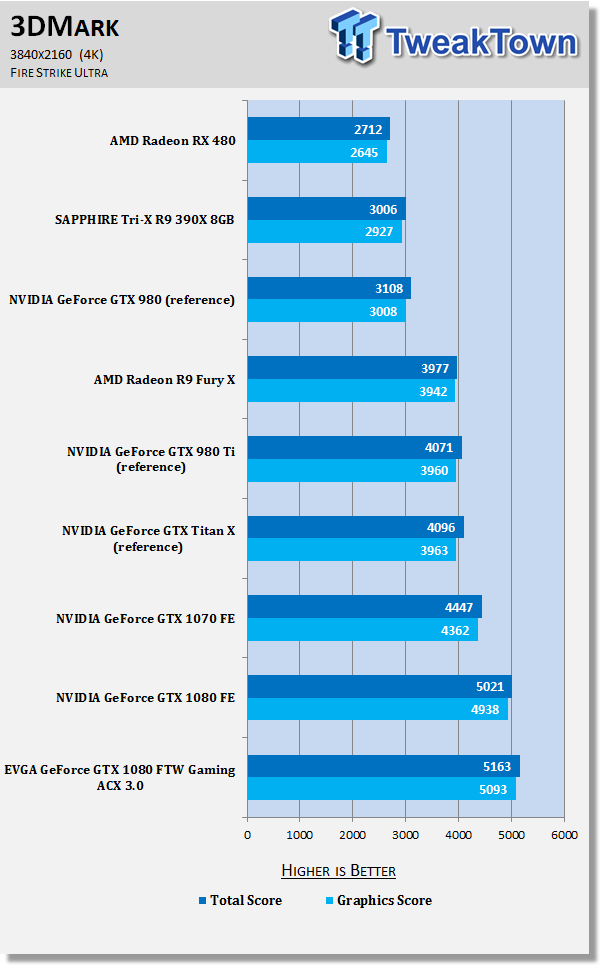
Heaven - 1080p

Heaven is an intensive GPU benchmark that really pushes your silicon to its limits. It's another favorite of ours as it has some great scaling for multi-GPU testing, and it's great for getting your GPU to 100% for power and noise testing.
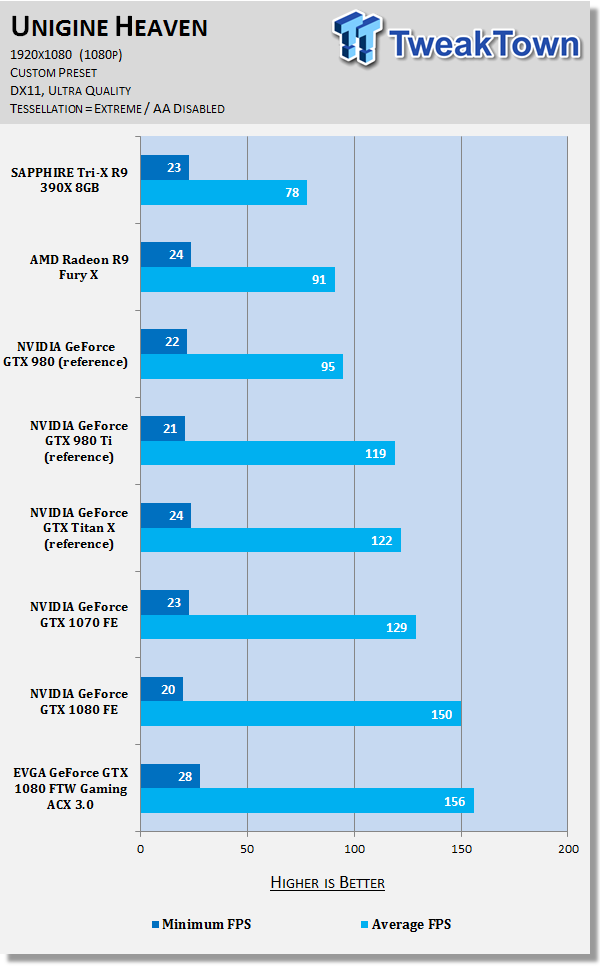
Heaven - 1440p
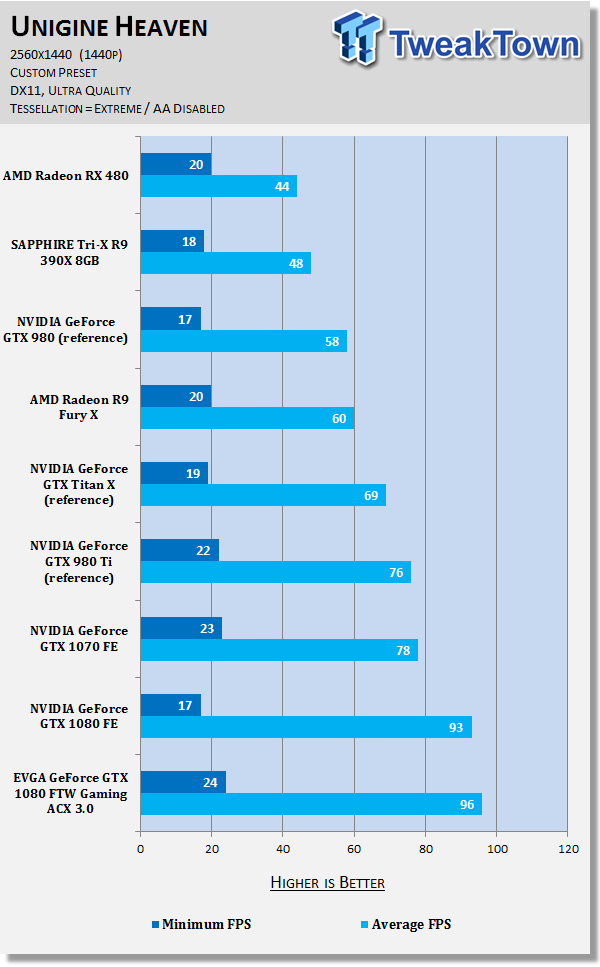
Heaven - 4K (3840x2160)
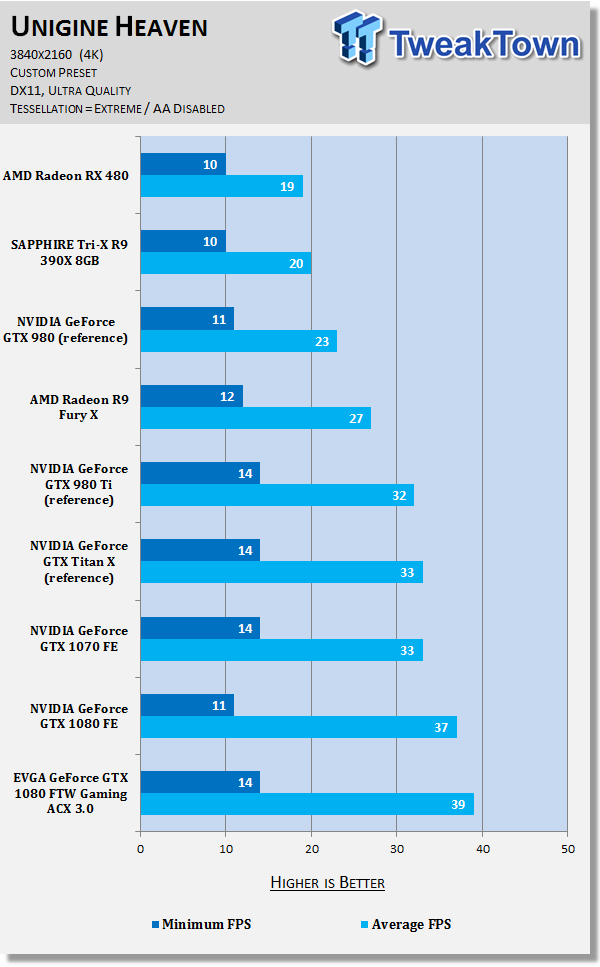
Benchmarks @ 1080p
1080p Benchmarks

Far Cry Primal is a game built on the impressive Dunia Engine 2 with wide open, beautiful environments. It might look stunning, but the performance is actually quite good - but most cards will be stressed at 1440p, and especially so at 4K and beyond.
You can buy Far Cry Primal at Amazon.


Tom Clancy's The Division is one of the best looking games on the market, build with the beautiful Snowdrop engine. It's an RPG, including some awesome PvP multiplayer, and some of the best graphics on the market. It really stresses systems out, especially at 4K, making it perfect to test with our various video cards.
You can buy The Division at Amazon, and you can read our full review here.


We recently changed over to Metro: Last Light Redux, with developer 4A Games making the Redux version of Metro: Last Light the 'definitive' version of the game. Redux had a fresh coat of paint on the already impressive 4A Engine, and it really pushes our GPUs to their limits.
You can buy Metro: Last Light Redux at Amazon.
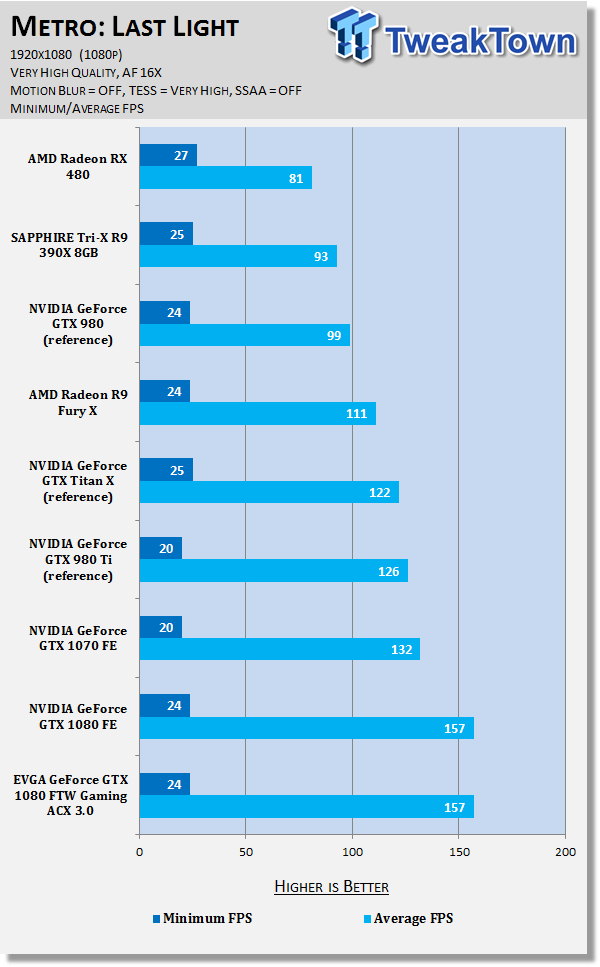

Middle-earth: Shadow of Mordor is one of the most graphically intensive games we test, with Monolith using their own Lithtech engine to power the game. When cranked up to maximum detail, it will chew through your GPU and its VRAM like it's nothing.
You can buy Middle-earth: Shadow of Mordor at Amazon.
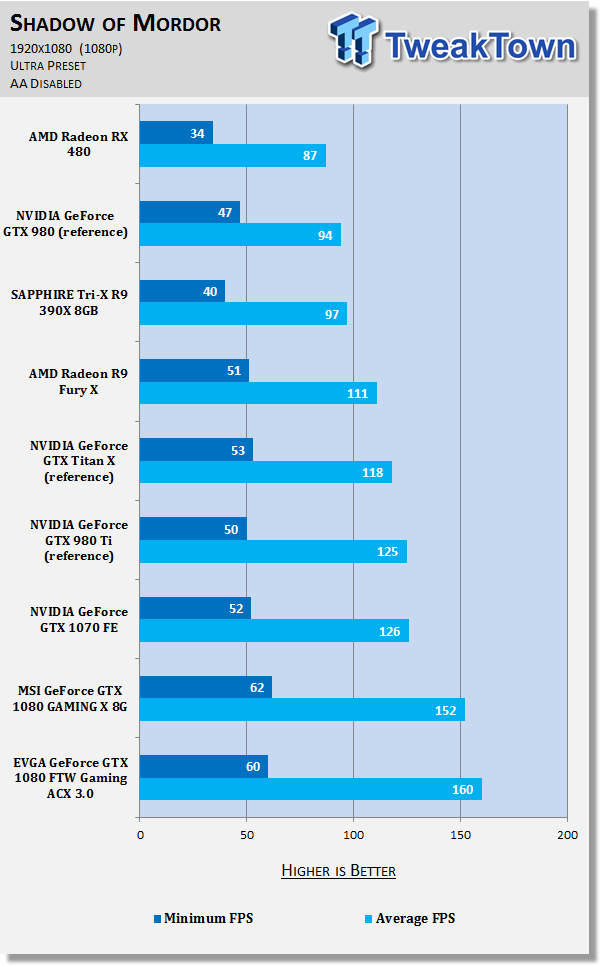

Thief has been around for quite a while now, with the latest version of the first-person stealth game powered by Epic Games' older Unreal Engine 3. While it's old, it has some great multi-GPU scaling that we use to test out our various GPU setups.
You can buy Thief at Amazon.
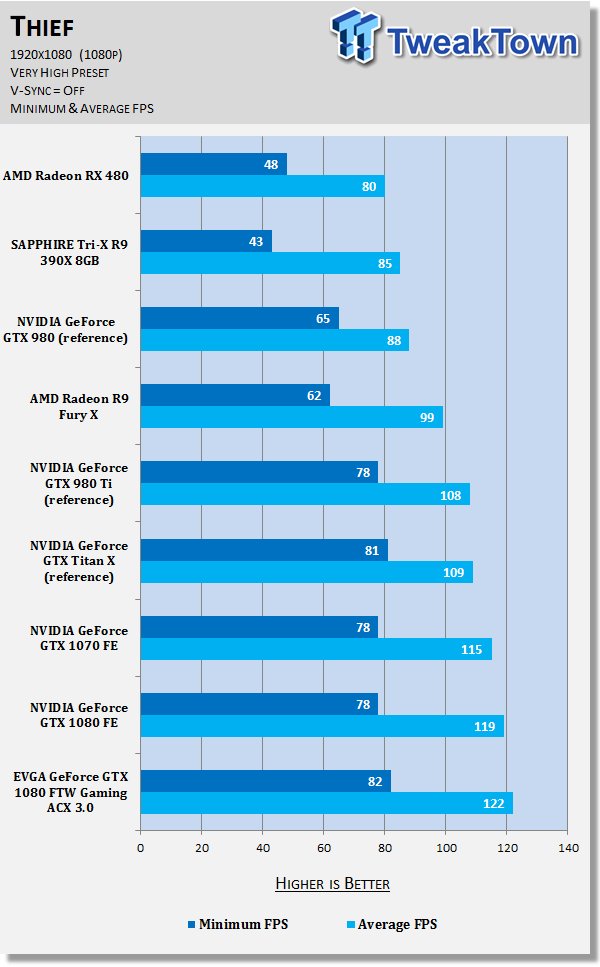

Tomb Raider is still such a gorgeous game, with developer Crystal Dynamics using their own 'Foundation' engine to build Lara Croft into the new world. One of the best parts about Tomb Raider is the absolutely stellar multi-GPU scaling, so this is an important test to see how well our NVIDIA GeForce SLI and AMD Radeon Crossfire setups scale.
You can buy Tomb Raider at Amazon.
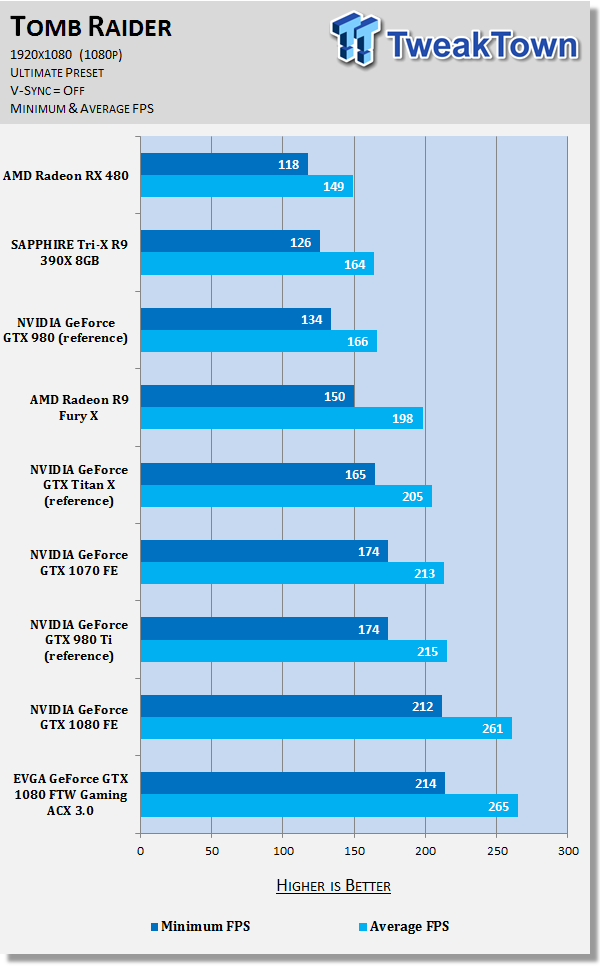
Benchmarks @ 1440p
1440p Benchmarks

Far Cry Primal is a game built on the impressive Dunia Engine 2 with wide open, beautiful environments. It might look stunning, but the performance is actually quite good - but most cards will be stressed at 1440p, and especially so at 4K and beyond.
You can buy Far Cry Primal at Amazon.
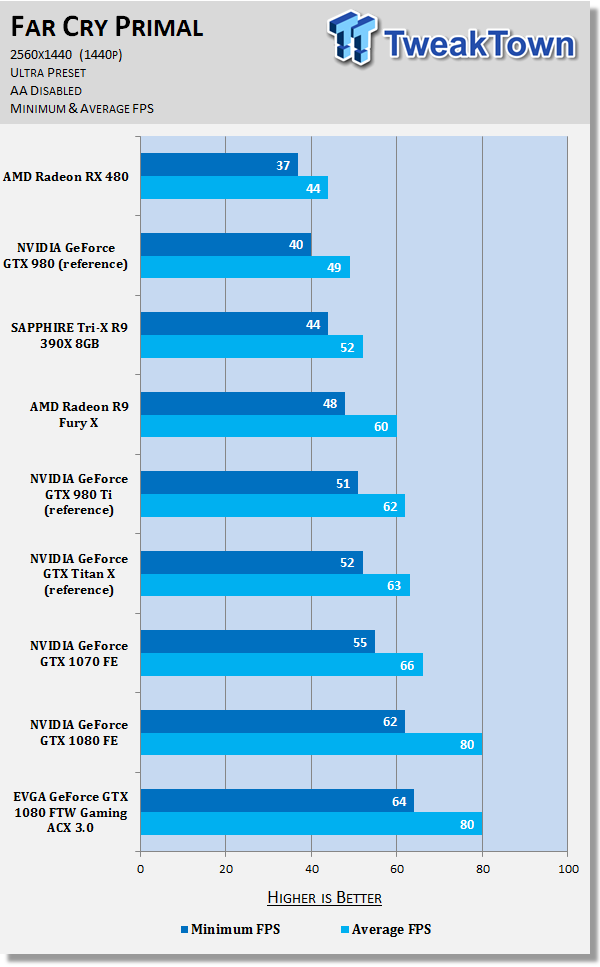

Tom Clancy's The Division is one of the best looking games on the market, build with the beautiful Snowdrop engine. It's an RPG, including some awesome PvP multiplayer, and some of the best graphics on the market. It really stresses systems out, especially at 4K, making it perfect to test with our various video cards.
You can buy The Division at Amazon, and you can read our full review here.
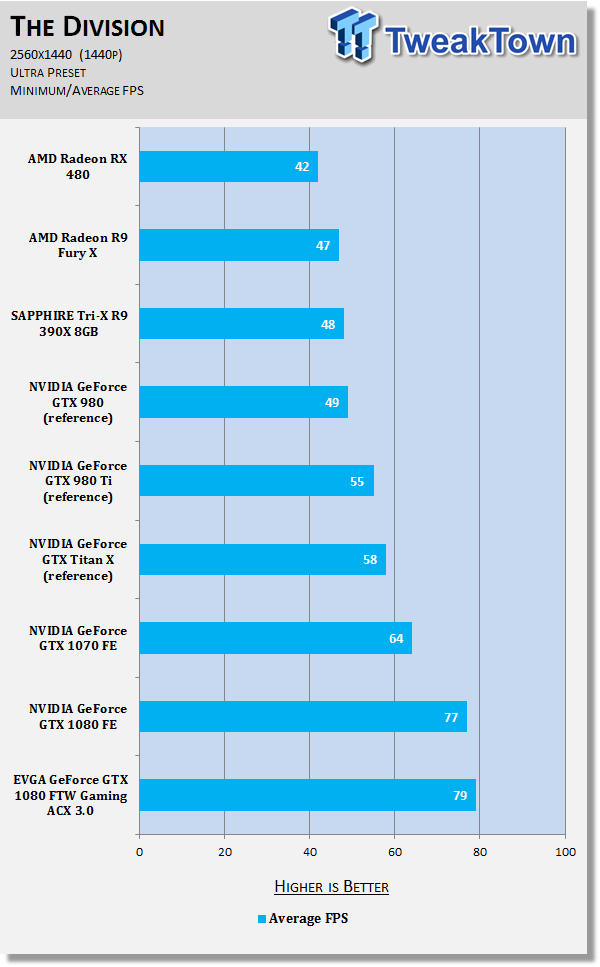

We recently changed over to Metro: Last Light Redux, with developer 4A Games making the Redux version of Metro: Last Light the 'definitive' version of the game. Redux had a fresh coat of paint on the already impressive 4A Engine, and it really pushes our GPUs to their limits.
You can buy Metro: Last Light Redux at Amazon.
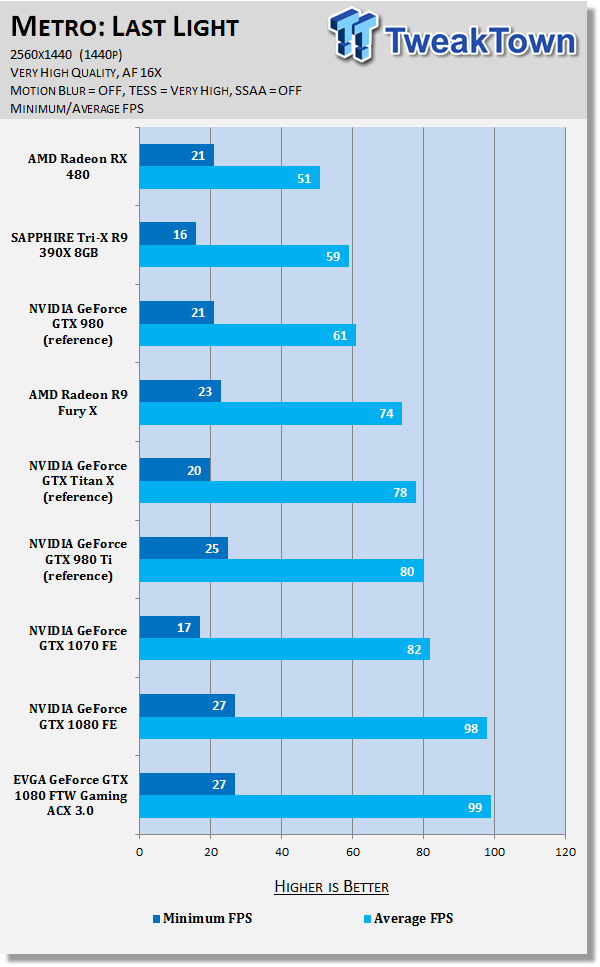

Middle-earth: Shadow of Mordor is one of the most graphically intensive games we test, with Monolith using their own Lithtech engine to power the game. When cranked up to maximum detail, it will chew through your GPU and its VRAM like it's nothing.
You can buy Middle-earth: Shadow of Mordor at Amazon.
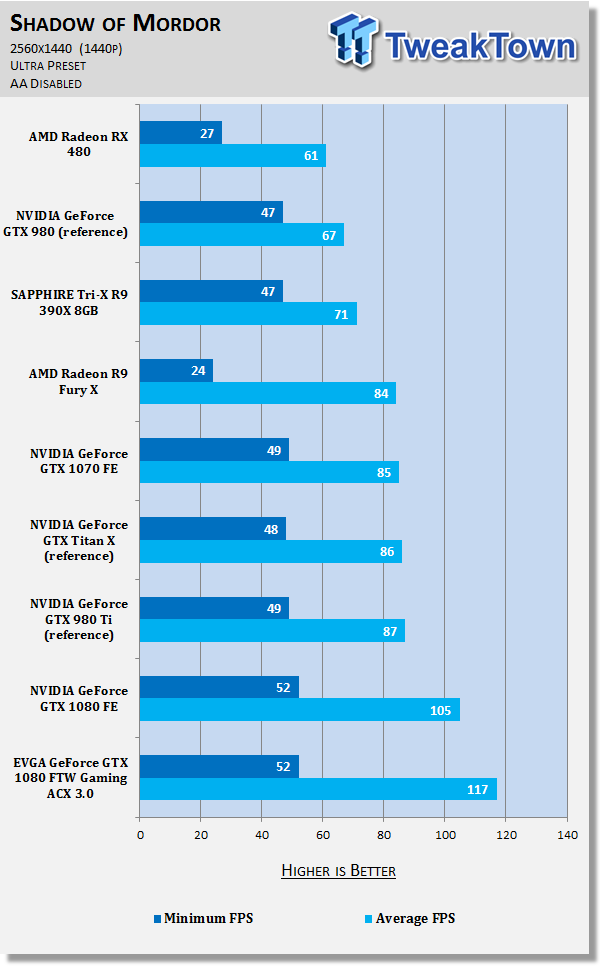

Thief has been around for quite a while now, with the latest version of the first-person stealth game powered by Epic Games' older Unreal Engine 3. While it's old, it has some great multi-GPU scaling that we use to test out our various GPU setups.
You can buy Thief at Amazon.
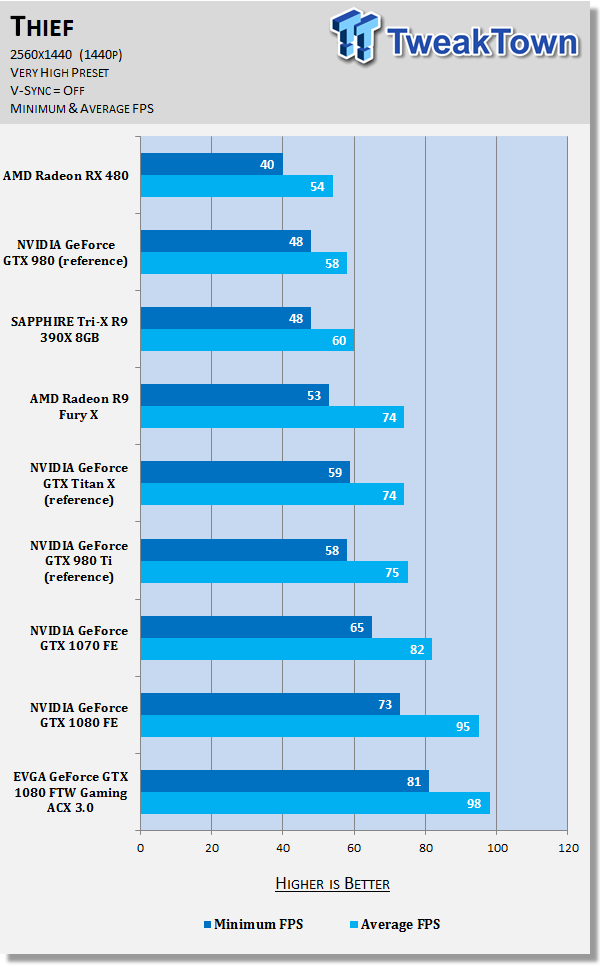

Tomb Raider is still such a gorgeous game, with developer Crystal Dynamics using their own 'Foundation' engine to build Lara Croft into the new world. One of the best parts about Tomb Raider is the absolutely stellar multi-GPU scaling, so this is an important test to see how well our NVIDIA GeForce SLI and AMD Radeon Crossfire setups scale.
You can buy Tomb Raider at Amazon.
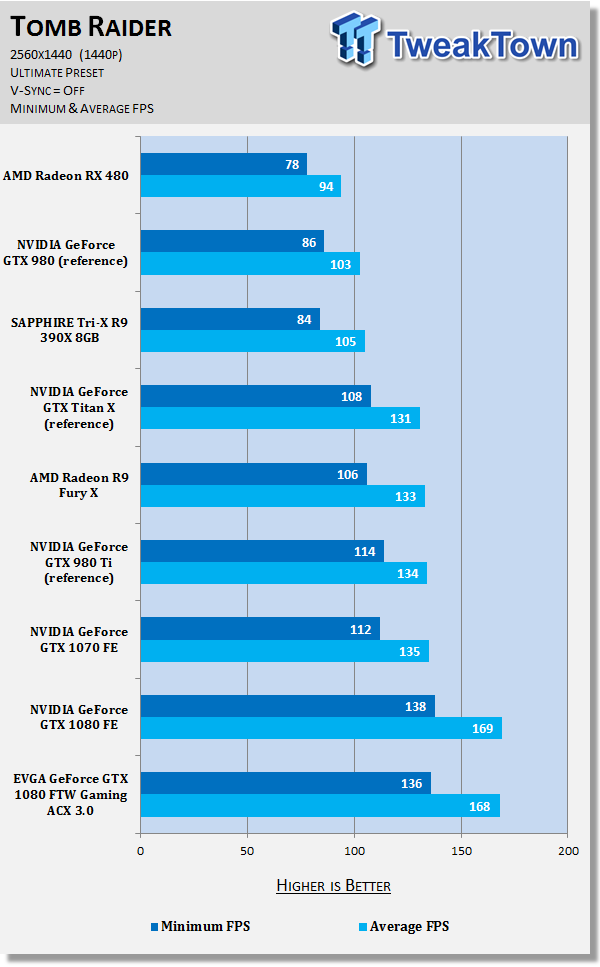
Benchmarks @ 4K
4K Benchmarks

Far Cry Primal is a game built on the impressive Dunia Engine 2 with wide open, beautiful environments. It might look stunning, but the performance is actually quite good - but most cards will be stressed at 1440p, and especially so at 4K and beyond.
You can buy Far Cry Primal at Amazon.
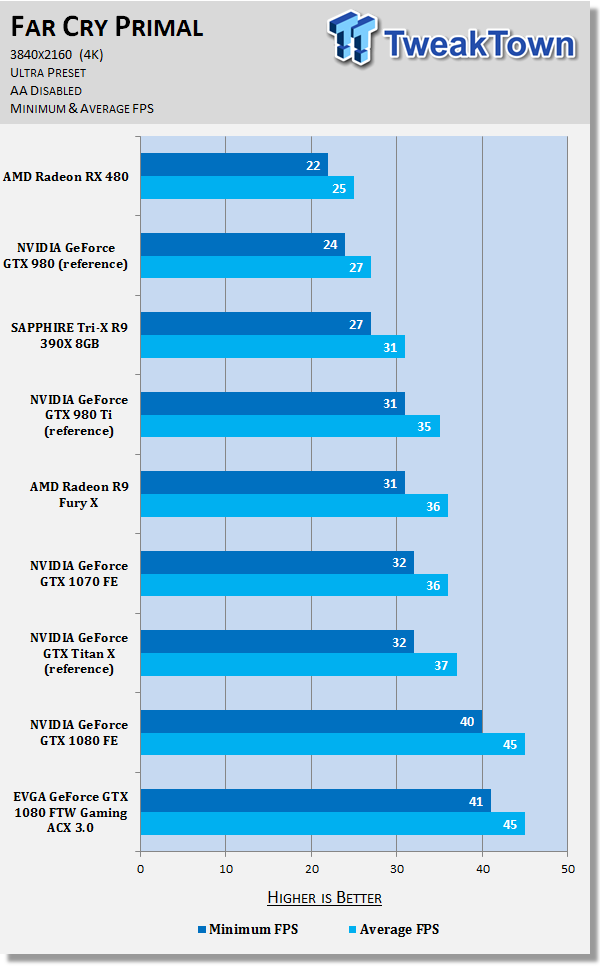

Tom Clancy's The Division is one of the best looking games on the market, build with the beautiful Snowdrop engine. It's an RPG, including some awesome PvP multiplayer, and some of the best graphics on the market. It really stresses systems out, especially at 4K, making it perfect to test with our various video cards.
You can buy The Division at Amazon, and you can read our full review here.
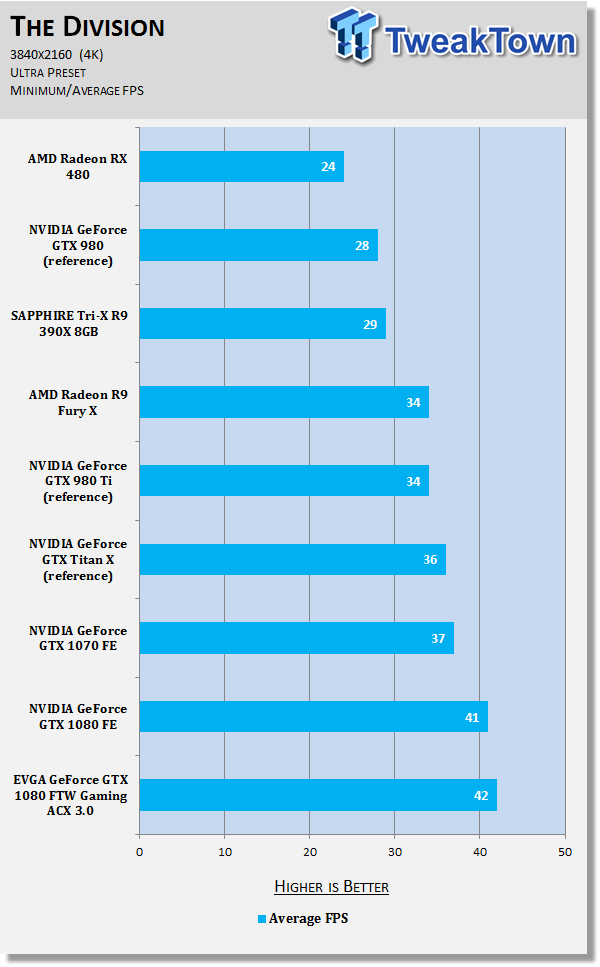

We recently changed over to Metro: Last Light Redux, with developer 4A Games making the Redux version of Metro: Last Light the 'definitive' version of the game. Redux had a fresh coat of paint on the already impressive 4A Engine, and it really pushes our GPUs to their limits.
You can buy Metro: Last Light Redux at Amazon.
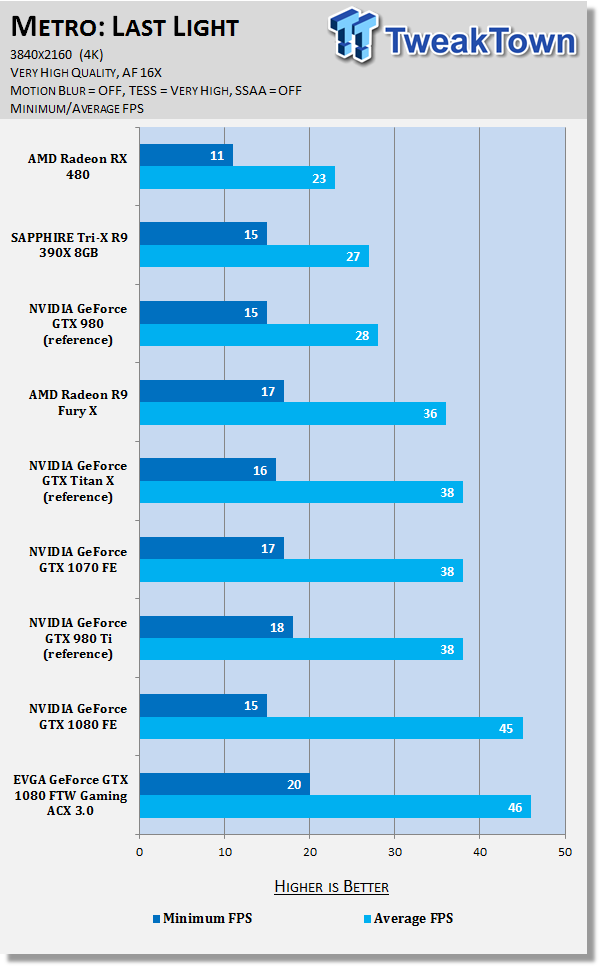

Middle-earth: Shadow of Mordor is one of the most graphically intensive games we test, with Monolith using their own Lithtech engine to power the game. When cranked up to maximum detail, it will chew through your GPU and its VRAM like it's nothing.
You can buy Middle-earth: Shadow of Mordor at Amazon.
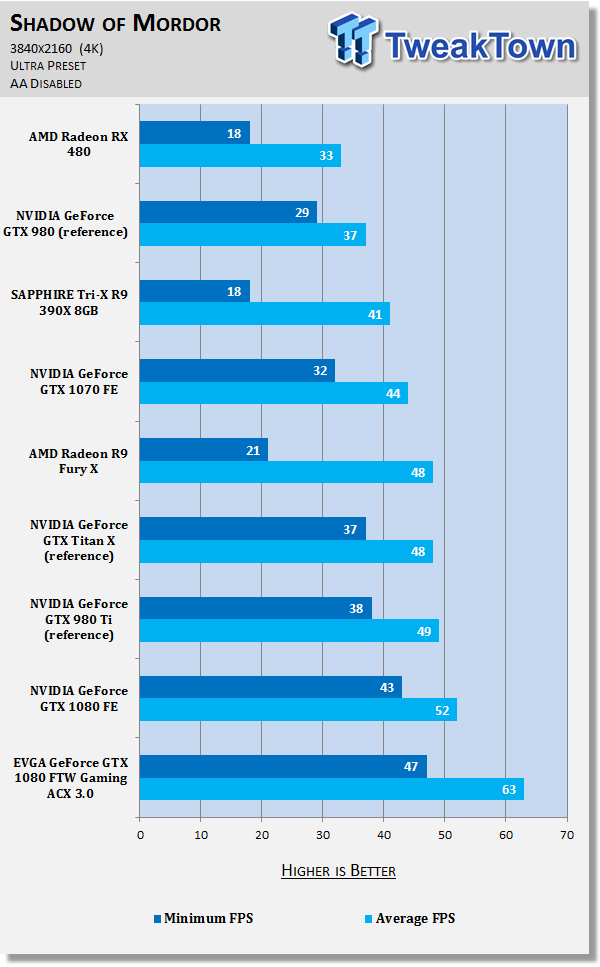

Thief has been around for quite a while now, with the latest version of the first-person stealth game powered by Epic Games' older Unreal Engine 3. While it's old, it has some great multi-GPU scaling that we use to test out our various GPU setups.
You can buy Thief at Amazon.
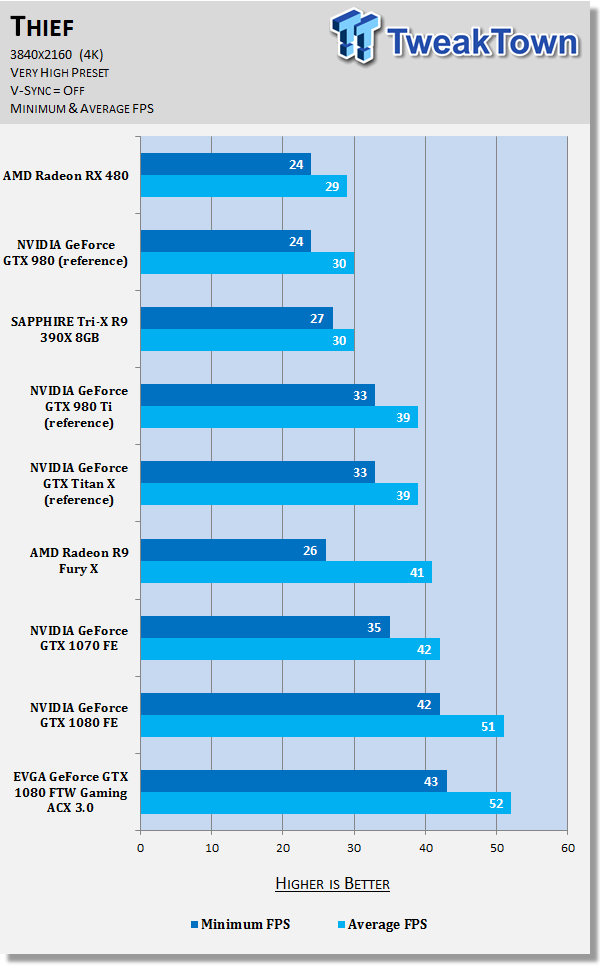

Tomb Raider is still such a gorgeous game, with developer Crystal Dynamics using their own 'Foundation' engine to build Lara Croft into the new world. One of the best parts about Tomb Raider is the absolutely stellar multi-GPU scaling, so this is an important test to see how well our NVIDIA GeForce SLI and AMD Radeon Crossfire setups scale.
You can buy Tomb Raider at Amazon.
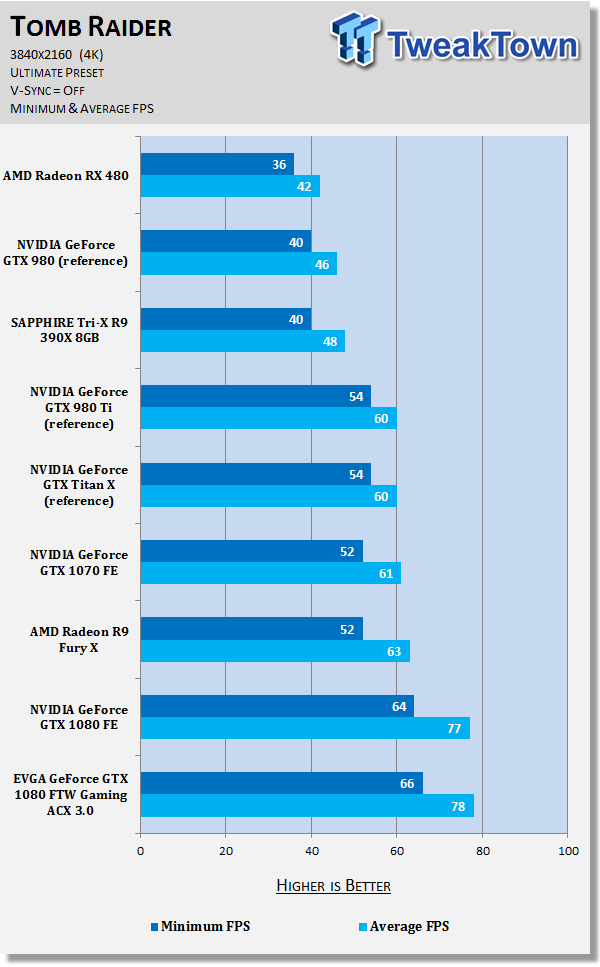
Benchmarks - DX12 & OC Adventures
This is our new section for video card reviews, with DX12 and VR becoming a huge deal over the course of the last 12 months. We have just a handful of DX12 tests right now, so expect this section of the site and our reviews to grow considerably over the coming months.
The same goes for VR, where we have both the Oculus Rift and HTC Vive in house now. We will be testing VRMark for now, which is in Preview form, as well as our thoughts on VR gaming on the HTC Vive with the new GeForce GTX 1080 video card.
DirectX 12 Performance
We have Ashes of the Singularity and Hitman with DirectX 12, with some great results from EVGA GeForce GTX 1080 FTW GAMING ACX 3.0 video card.

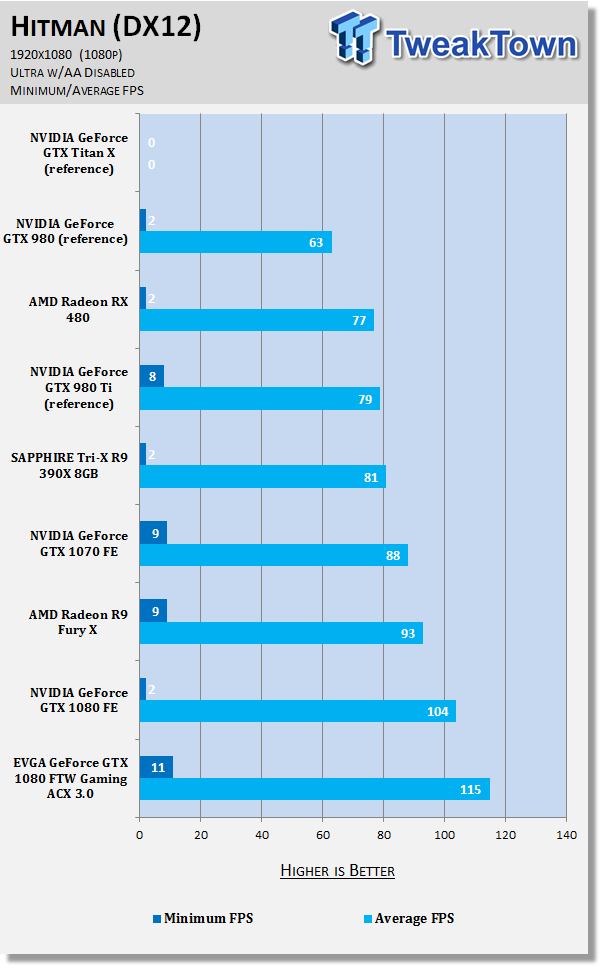
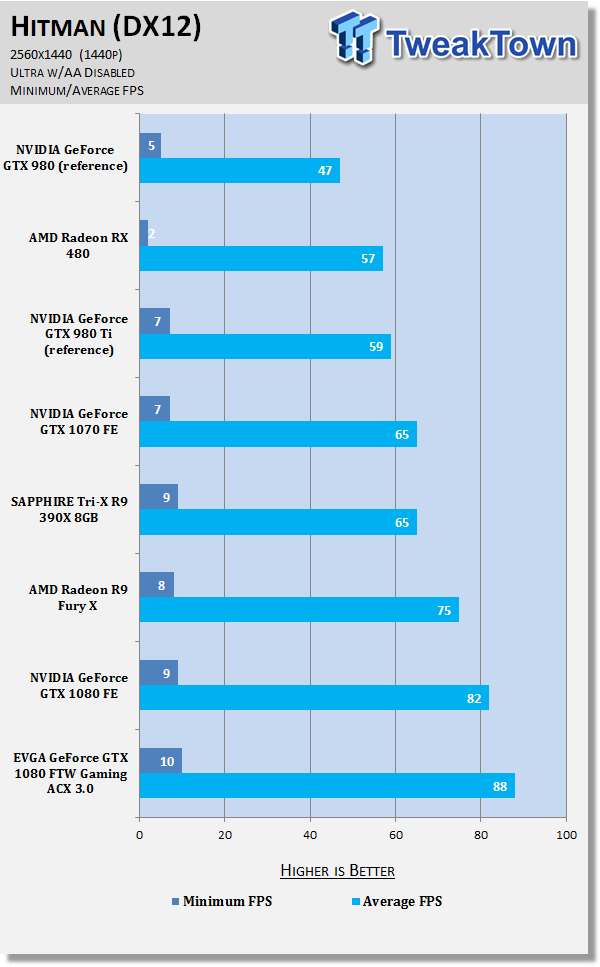
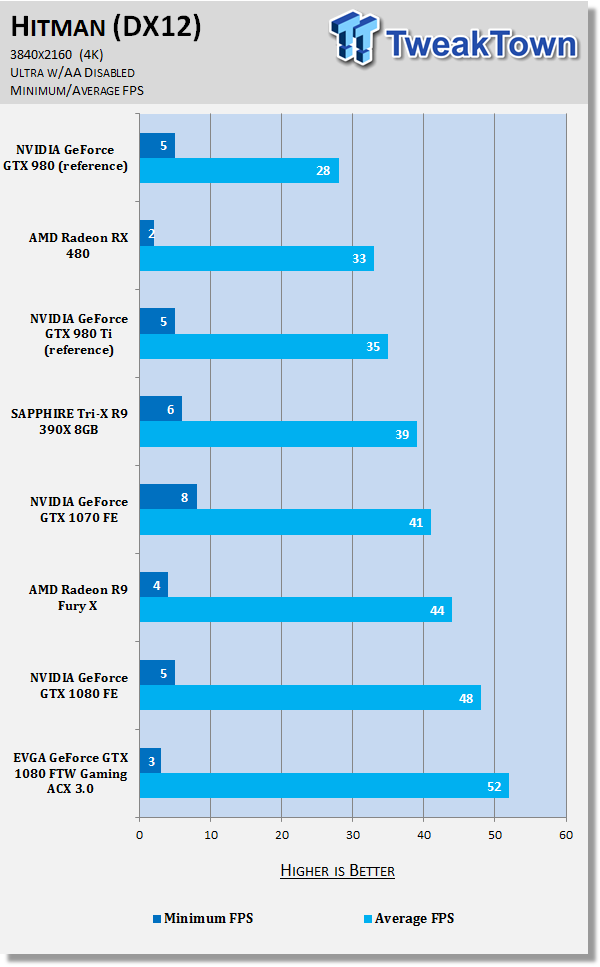


Overclocking Adventures - I Expected More...
When I found out that the EVGA GeForce GTX 1080 FTW GAMING ACX 3.0 was on its way, I expected big things from it. I knew the performance would nail the GTX 1080 Founders Edition, but I wanted to see another 10-15% on top, and sadly - we never reached those heights.
This isn't EVGA's fault, as it seems that all GeForce GTX 1080 cards aren't capable of being pushed much past the heights of the GTX 1080 Founders Edition. EVGA has done its best with the ACX 3.0 cooling technology on the GTX 1080 FTW GAMING ACX 3.0 card, with silent gaming and a little wiggle room for overclocking. I was able to reach 2075MHz on the Boost, which is a damn good result - but it wasn't completely stable in our suite of benchmarks.
The EVGA GeForce GTX 1080 FTW GAMING ACX 3.0 was much more comfortable at around 2050MHz, which is where we kept it for our overclocking adventures. I was able to squeeze an additional 375MHz on the RAM, and when both were pushed to their maximum OC, the GTX 1080 FTW GAMING ACX 3.0 and our test bed consumed around 350W of power, 60W more than the 290W at stock speeds.
The additional performance was welcomed, as you can see in our 3DMark FireStrike benchmarks:

3DMark Fire Strike - 1080p
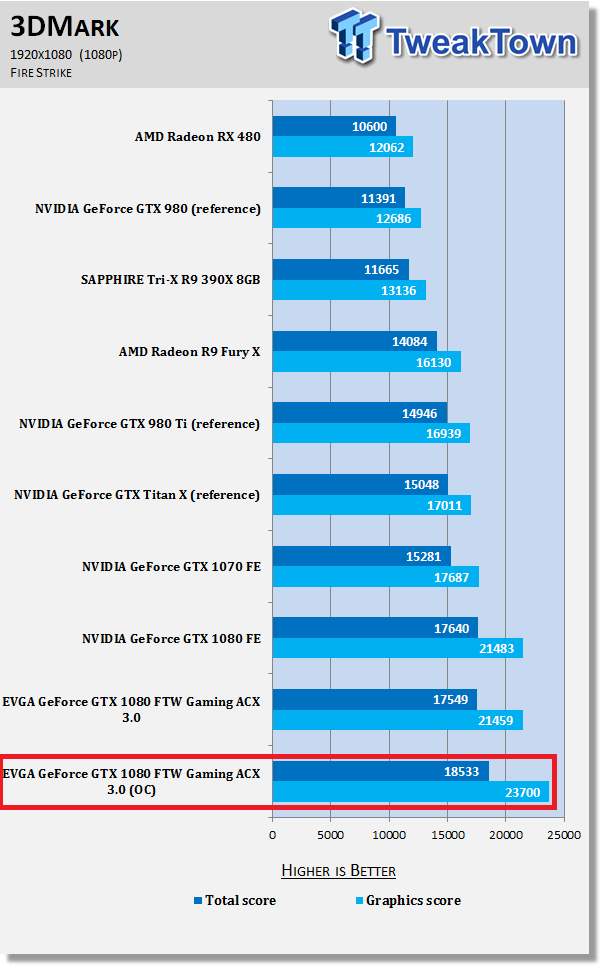
3DMark Fire Strike Extreme - 1440p

3DMark Fire Strike Ultra - 4K (3840x2160)
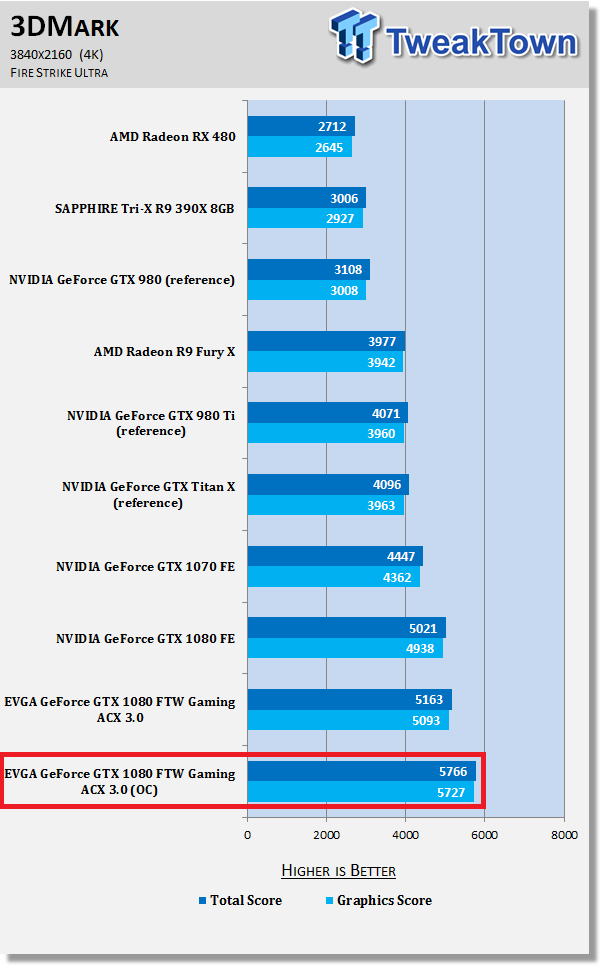
Power, Temperature, & Noise
290W Under Full Load, 350W Overclocked
I wasn't expecting any huge shifts in power consumption numbers on EVGA's GeForce GTX 1080 FTW GAMING ACX 3.0 card, and I wasn't surprised with the results, either. The GTX 1080 FTW GAMING ACX 3.0 card in our test bed had a total system power draw of around 290W, and while overclocked these numbers jumped to 350W.
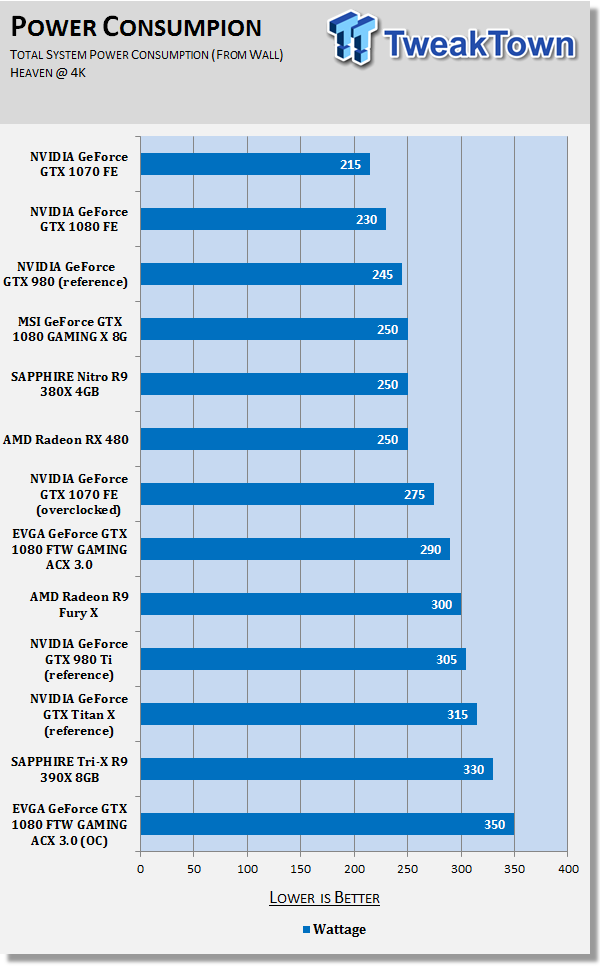
Not bad at all, but it's a little more than the 250W total system draw from NVIDIA's GeForce GTX 1080 Founders Edition, and even MSI's GeForce GTX 1080 Gaming X 8G.
40W more isn't too bad, as it's just over 10% - but the overclocked numbers are something you'll want to keep an eye on - especially if SLI was something you wanted to do. Two of these cards in SLI would have a total system draw of 700W+, so you're going to want a quality 850W or higher PSU with two in SLI.
Temperature & Noise
If there's something I love with these custom GeForce GTX 1080s, it's that they all perform so damn well, but the AIB partners have made the experience silent during load. EVGA has used its new ACX 3.0 cooler as its best asset on the GTX 1080 FTW GAMING 3.0 card, with it not only keeping the entire card nice and cool under heavy load but silent at the same time.

Sure, you can ramp up the fans in the fan profile and push a higher manual RPM speed, but there's no need - as the standard OC profiles on the card have finely tuned communication with the ACX 3.0 cooler to keep it cool enough without needing manual intervention. Cooling a video card is something EVGA excels at, and that's very welcomed with the GTX 1080 FTW GAMING ACX 3.0.
Final Thoughts
PrecisionX OC Software
EVGA has been slowly making its PrecisionX OC software one of the key parts of its graphics card revolution, with the next-generation of EVGA PrecisionX launching with Pascal. This new version of EVGA's PrecisionX OC software unlocks the power of the Pascal architecture, while the super useful EVGA OC Scanner is included. You can grab PrecisionX OC right here.
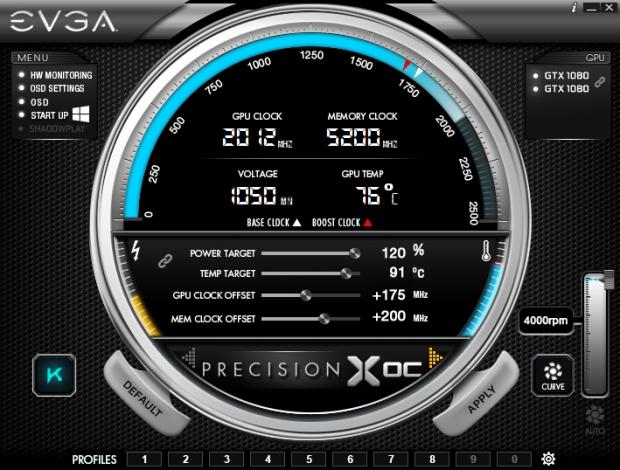
EVGA's new PrecisionX OC software includes exclusive features for EVGA's GeForce GTX 1080 and GTX 1070 cards, including:
- DirectX 12 OSD Support - See the on screen display on DirectX 12 games.
- EVGA OC ScannerX Integration - Automatically find your optimal voltage/frequency curve!
- K-Boost Function - Maximize your clocks with this exclusive feature.
- RGB LED control (on EVGA GeForce GTX 1080 FTW)
I have been using PrecisionX OC on all of my GPU reviews, as it really is a hugely useful piece of software. The GPU monitoring on its own, alongside the built in OC scanning software is beyond useful for testing and pushing your graphics card to the limit.
EVGA has always impressed me with their cards, where over the years I've owned and recommended (and even sold them at my old day job pre-TweakTown) without any problems. This reputation took years to build, and it's something that continues into their new GeForce GTX 1070 and GTX 1080 cards - and we're only at the beginning here with their GeForce GTX 1080 FTW GAMING ACX 3.0 card.

One of EVGA's best-selling products is their Classified cards, which we saw at Computex in June. EVGA's upcoming GeForce GTX 1080 Classified is sure to beat the FTW GAMING ACX 3.0 card, with higher overclocks and hopefully some additional headroom for even more overclocking. It retains the awesome ACX 3.0 cooler, which is something that stood out on the GTX 1080 FTW GAMING ACX 3.0 card.
The ACX 3.0 cooler didn't make any noise during my hours upon hours of gaming and benchmark punishment, which is another tick in EVGA's box. After seeing the huge coolers on ZOTAC and GIGABYTE's new GeForce GTX 1080s (reviews on those to follow this one), I thought EVGA's card wouldn't perform or overclock as well, but I was wrong. It overclocked without a problem, and while it didn't hit the heights I thought it would, I think EVGA are saving those heights for the Classified card.
All in all, if you're an EVGA fan, and you've been waiting for their GeForce GTX 1080, their new FTW GAMING ACX 3.0 card is a great choice. It is one of the best looking GTX 1080s on the market right now with its beautiful and feature-packed ACX 3.0 cooler, retaining the 2-slot sizing without having a huge bulky cooler that doesn't add to the overclocking headroom.
EVGA's new GeForce GTX 1080 FTW GAMING ACX 3.0 is one of the best-looking GP104-powered cards on the market right now, with some stellar performance and silent cooling. I expected nothing less than class with EVGA's new card, and I received exactly what I wanted to see - a great performing card that sprinkles some magic onto the already great GTX 1080 from NVIDIA.

